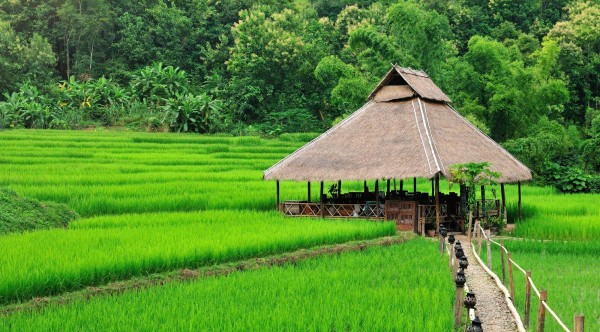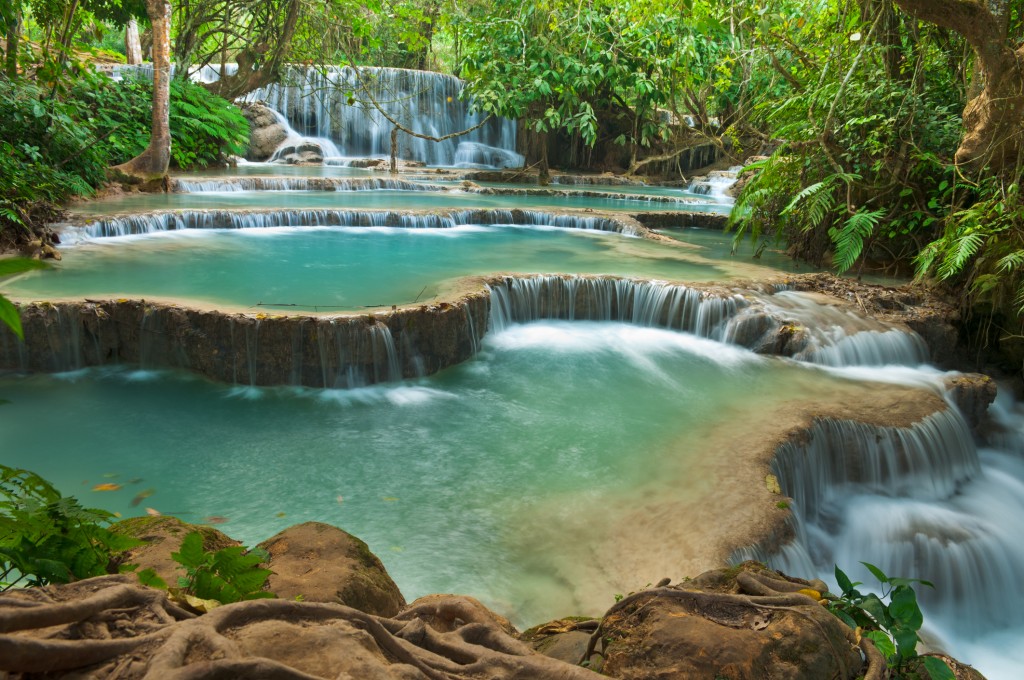
Luang Prabang

Luang Prabang

Colour is the first of Luang Prabang’s virtues to greet travellers. Pearly frangipanis with their heady perfume, banks of overgrown trees peppered with scarlet flowers, the burnt sienna robes of hundreds of monks and their novices, and resplendent gold and claret wats. The scent of fresh coffee, river activity, produce markets and spicy food soon follows. And then the broader aesthetics begin to unfold. Encircled by mountains, and set 700m above sea level at the confluence of the Nam Khan (Khan River) and the Mekong River, Luang Prabang is now Lao’s foremost tourist showpiece. The brew of gleaming temple roofs, crumbling French provincial architecture and multiethnic inhabitants captivates even the most jaded travellers, and the quiet benevolence of the city’s residents lulls them into a somnambulant bliss.
When the best time to visit Luang Prabang
Surrounded by jungle, with the Mekong River flowing through, Luang Prabang enjoys a tropical monsoon climate. There are two seasons in this weather: one dry and one wet. The dry season comes from November to May while the rainy season lasts from May to October.
The best time of the year to visit is between October to March when the temperatures are in the comfortable 70s.
Getting There & Away
Air
Around 4km from the city Centre, Luang Prabang International Airport is decidedly modest, though big expansion plans are afoot.
– Bangkok Airways
– Lao Airlines
– Vietnam Airlines
Please contact us to book flight ticket.
Tuk- tuks
Luang Prabang has no motorbike taxis, only tuk-tuks, plus the odd taxi-van from the airport charging a standardised 50,000K into town. These will cost more if more than three people share the ride. From town back to the airport you might pay marginally less.
Motorcycle & Bicycle
A much more satisfying way to get around is by bicycle. They’re rented by numerous shops and some guesthouses for 15,000K to 30,000K per day.
Motorcycle rental typically costs US$15 a day or US$20 for 24 hours.
Boat
For slowboats to Pak Beng (110,000K, nine hours, 8am), buy tickets from the navigation office behind the Royal Palace. Through-tickets to Huay Xai (220,000K, two days) are also available but you’ll have to sleep in Pak Beng; curiously it’s slightly cheaper to pay the fare to Pak Beng, and then buy the onward section there. This also allows you to stay a little longer in Pak Beng should you like the place. The main slowboat landing is directly behind the navigation office but departure points can vary according to river levels.
The more upscale Luang Say Cruise departs on two-day rides to Huay Xai from the Xieng Thong jetty opposite Wat Xieng Thong. Rates include an overnight stay at the Luang Say Lodge in Pak Beng. A cheaper alternative is Shompoo Cruise, a two-day cruise aboard a smart boutique boat. Accommodation in Pak Beng is not included.
Fast but uncomfortable and seriously hazardous six-person speedboats can shoot you up the Mekong to Pak Beng (250,000K, three hours) and Huay Xai (400,000K, seven hours). However there are no fixed departure times and prices assume a full boat so unless you organise things through an agency, it’s worth heading up to the speedboat station the day before to make enquiries. It’s around 5km north of town: turn west off Rte 13 beside the Km 390 post then head 300m down an unpaved road that becomes an unlikely dirt track once you cross the only crossroads en route.
River levels permitting, Mekong River Cruises makes lazy seven-day trips from Luang Prabang to Thailand’s Golden Triangle on innovative new two-storey German-Lao riverboats with a sun deck and sixteen cabins in which you sleep as well as travel (departs Thursdays).
Numerous boats for the Pak Ou Caves depart between 8.30am and lunchtime. A single boat to Nong Khiaw (110,000K, six hours) departs around 8.30am assuming enough people have signed up. Buy tickets at the easily missed little longboat office.
Banana Boat Laos offer better organized boat trips for those who aren’t worried about every last kip. Boats leave from behind the Royal Palace Museum.
Sights & Activities
Royal Palace Museum
Perfectly framed by an avenue of tall Palmyra palms, the former Royal Palace was built in 1904, blending traditional Lao and French beaux-arts styles. It was the main residence of King Sisavang Vong (r 1905–59) whose statue stands outside. Exhibits are well labelled in English. Note that you must be ‘appropriately dressed’ to enter, which means no sleeveless shirts or short shorts.
Wat Xieng Thong
Luang Prabang’s best-known and most visited monastery is centred on a 1560 sǐm that’s considered a classic of local design. Its roofs sweep low to the ground and there’s an idiosyncratic ‘tree of life’ mosaic set on its west exterior wall. Inside, gold stencil work includes dharma wheels on the ceiling and exploits from the life of legendary King Chanthaphanit on the walls. During 1887 when the Black Flag army sacked the rest of the city, Xieng Thong was one of just two temples to be (partially) spared. The Black Flag’s leader, Deo Van Tri, had studied here as a monk earlier in his life and used the desecrated temple as his headquarters during the invasion.
Phu Si
Dominating the old city centre and a favourite with sunset junkies, the abrupt 100m-tall hill of Phu Si is crowned by a 24m gilded stupa called That Chomsi . Viewed from a distance, especially when floodlit at night, the structure seems to float in the hazy air. From the summit, however, the main attraction is the series of city views. Beside a flagpole on the same summit there’s a small remnant anti-aircraft cannon left from the war years.
Ascending Phu Si from the north side (329 steps), stop at the decaying Wat Pa Huak , one of the few city temples not to have been colourfully (over) renovated. It has a splendid carved wood Buddha riding Airavata, the three-headed elephant from Hindu mythology that featured on Laos’ national flag until 1975. The gilded and carved front doors are often locked, but during the day there’s usually an attendant nearby who will open the doors for a tip of a few thousand kip. Inside, the original 19th-century murals have excellent colour, considering the lack of any restoration. The murals show historic scenes along the Mekong River, including visits by Chinese diplomats and warriors arriving by river and horse caravans. Three large seated Buddhas and several smaller standing and seated images date from the same time as the murals or possibly earlier.
Wat Mai Suwannaphumaham
Beside the palace, Wat Mai is one of the city’s most sumptuous monasteries. Its wooden sǐm (ordination hall) has a five-tiered roof in archetypal Luang Prabang style, while the unusually roofed front verandah features detailed golden reliefs depicting scenes from village life, the Ramayana and Buddha’s penultimate birth.
When built in 1821 to replace a 1796 original, this was the mai (new) monastery. The name has stuck. It was spared destruction in 1887 by the Haw gangs who reportedly found it too beautiful to harm. Since 1894 it has been home to the Sangharat, the head of Lao Buddhism.
TAEC
Visiting this professionally presented three-room museum is a must to learn about northern Laos’ various hill-tribe cultures, especially if planning a trek. There’s just enough to inform without overloading a beginner. If you want more information, watch the video or ask to leaf through the books of a small library cabinet in the museum’s delightful cafe. TAEC is within a former French judge’s mansion that was among the city’s most opulent buildings of the 1920s.
Wat Wisunarat
Facing That Makmo, this wat takes its name from Chao Wisunarat (King Visoun), who founded it in 1513. Though touted as one of Luang Prabang’s oldest operating temples it’s actually an 1898 reconstruction built following the Black Flag raids. As a rather meagre return for paying the entrance fee you can peruse a sizeable collection of old gilded ‘Calling for Rain’ Buddhas with long sinuous arms held to each side. These were placed here, along with some medieval ordination stones, for their protection having been rescued from various abandoned or ravaged temples.
OckPopTok Living Crafts Centre
Just beyond the extensive Talat Market, a tiny lane leads 200m towards the Mekong emerging at the excellent OckPopTok Living Crafts Centre, a beautifully laid-out traditionally styled workshop where weavers, spinners and batik makers produce top-quality fabrics. Free tours of the center start roughly half-hourly and give a superb insight into silk production and dye-making.
Wat That Luang
Traditionally the cremation site for Lao royalty, legend has it that Wat That Luang was originally established by Ashokan missionaries in the 3rd century BC. However, the current large sǐm is a 1818 rebuild whose leafy column-capitals look more Corinthian than Indian. The sǐm is bracketed by two stupas, the larger of which is plated with an armour of corroded old brass plates. It reputedly contains the ashes of King Sisavang Vong, even though it was built in 1910, 50 years before his death.
Eating
Dyen Sabai:
One of Luang Prabang’s top destinations for fabulous Lao food. The eggplant dip and the fried Mekong riverweed here are as good as anywhere. Most seating is on recliner cushions in rustic open-sided pavilions. It’s a short stroll across the Nam Khan bamboo bridge in the dry season or a free boat ride at other times. Two-for-one cocktails between noon and 7pm.
Coconut Garden
An excellent 100,000K vegetarian set meal provides five top-quality Lao dishes, which allows a single diner to create the subtle palate of flavours that you’d normally only get from a multiperson feast. Coconut Garden has front and rear yards, and is a great spot for lunch or dinner. International favourites are also available.
Tamarind
On the banks of the Nam Khan next to Apsara hotel, chic Tamarind has created its very own strain of ‘Mod Lao’ cuisine. The à la carte menu boasts delicious sampling platters with bamboo dip, stuffed lemongrass and meuyang (DIY parcels of noodles, herbs, fish and chilli pastes, and vegetables).
Le Patio
Sip Phongsali smoked teas or Lao Arabica espressos and nibble delicious feta-olive baguette sandwiches on a shaded terrace with attractive mountain views. Ethnic minority dishes, such as Akha meatballs and Hmong pork belly, are also available.
Le Banneton
Offering the best croissants in Laos, this peaceful peninsula cafe is celebrated by pastry buffs for the quality of its flour. It has a sweet-toothed menu of pain au chocolat, fruit shakes, sandwiches, quiches and homemade sorbets.
Night Food Stalls
Food stalls emerge at dusk on a narrow street behind the tourist office with illuminated communal tables so you don’t have to eat on the hoof. There’s no better place to taste a wide variety of cheap yet well-cooked local food. There are plenty of vegetarian stalls offering a range of dishes for just 10,000K. Whole roast fish stuffed with lemongrass is a bargain at around 20,000K.
| Country | laos |
|---|

